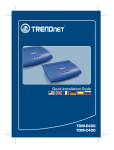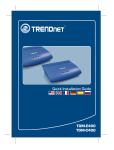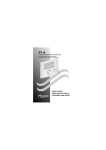Download Microsens MS453510 User manual
Transcript
4 10/100/1000TX + 1 Mini-GBIC Switch User Manual MS453510 CE Mark Warning This is a Class-A product. In a domestic environment this product may cause radio interference in which case the user may be required to take adequate measures. Content INTRODUCTION ............................................................................... 1 Features ............................................................................................................... 1 Package Contents ................................................................................................ 2 HARDWARE DESCRIPTION ............................................................ 3 Physical dimension .............................................................................................. 3 Front Panel........................................................................................................... 3 Rear Panel ........................................................................................................... 3 LED Indicators ...................................................................................................... 4 Desktop Installation .............................................................................................. 6 Attaching Rubber Feet .................................................................................. 6 Power On ............................................................................................................. 6 NETWORK APPLICATION ............................................................... 7 Small Workgroup .................................................................................................. 7 Segment Bridge ................................................................................................... 7 TROUBLESHOOTING ...................................................................... 9 Incorrect connections ........................................................................................... 9 Faulty or loose cables ..................................................................... 9 Non-standard cables ....................................................................... 9 Improper Network Topologies ....................................................... 10 Diagnosing LED Indicators ................................................................................. 10 TECHNICAL SPECIFICATION ....................................................... 11 APPENDIX ...................................................................................... 14 10 /100BASE-TX Pin outs .................................................................................. 14 10/100Base-TX Cable Schematic ...................................................................... 14 10/100/1000Base-TX Pin outs ........................................................................... 15 10/100/1000Base-TX Cable Schematic ............................................................. 16 Introduction The 4 10/100/1000TX + 1 Mini-GBIC Switch is a multi-port Switch that can be used to build high-performance switched workgroup networks. The Switch is targeted at workgroup or department. The 4 10/100/1000TX + 1 Mini-GBIC Switch features a “store-and-forward “ switching scheme that offers low latency for high-speed networking and allows the switch to auto-learn and store source address in a 8K-entry MAC address table. The 4 10/100/1000TX + 1 Mini-GBIC Switch has 4 auto-sensing 10/100/1000 Base-TX RJ-45 ports plus one MINI GBIC slot that enables extended distance connection. Features Conform to IEEE802.3 10BASE-T, IEEE802.3u 100BASE-TX Fast Ethernet, IEEE 802.3ab 1000Base-T, IEEE 802.3z Gigabit Fiber, IEEE802.3x Flow control and Back pressure Store-and-Forward switching architecture Auto-MDIX on all ports 10 Gbps back-plane N-Way Auto-Negotiation IEEE802.3x Flow control Back pressure with half duplex (10/100Mbps) Flow control with full duplex (10/100/1000Mbps) 8K MAC address table 112Kbytes memory buffer True non-blocking switching 1 Package Contents Unpack the contents of the 4 10/100/1000TX + 1 Mini-GBIC Switch and verify them against the checklist below: 4 10/100/1000TX + 1 Mini-GBIC Switch DC Power Cord Four Rubber Pads User Manual 4 10/100/1000TX + 1 Mini-GBIC Switch DC Power Adapter Four Rubber Pads User Manual Package Contents Compare the contents of your 4 10/100/1000TX + 1 Mini-GBIC Switch package with the standard checklist above. If any item is missing or damaged, please contact your local dealer for exchanging. 2 Hardware Description This section mainly describes the hardware of the 4 10/100/1000TX + 1 Mini-GBIC Switch, and gives a physical and functional overview on certain switch. Physical dimension The 4 10/100/1000TX + 1 Mini-GBIC Switch physical dimension is 165 x 100 x 32.5 mm (L x W x H). Front Panel The Front Panel of the 4 10/100/1000TX + 1 Mini-GBIC Switch consists of LED Indicators and a reset button. Please refer to the LED Indicator section for LED description. Reset button: it provides an easy way for user to reset the configuration back to the default settings. Press the button more than 5 seconds, and then the switch will restart and set all configurations back to the default settings. Rear Panel The rear panel consist the 4 10/100/1000Base-TX RJ-45 port, one Mini GBIC slot and DC Power Jack as shown in figure. The switch will work with DC in the range of 12V/0.8A. 3 The Rear Panel of 4 10/100/1000TX + 1 Mini-GBIC Switch RJ-45 Ports (Auto MDI/MDIX): 4x 10/100/1000 N-way auto-sensing for 10Base-T, 100Base-TX or 1000Base-T connections. In general, MDI means connecting to another Hub or Switch while MDIX means connecting to a workstation or PC. Therefore, Auto MDI/MDIX would allow connecting to another Switch or workstation without changing non-crossover or crossover cabling. Mini GBIC slot: The MINI GBIC module is optional, and with 3.3V supported. There is one LED indicator for Mini GBIC port – LNK/ACT. LED Indicators The LED Indicators display the real-time information of systematic operation status. Please see the definition of the LED indicators as below: LED Status Color Description On Green Power On Off -- On Green Power 100/1000 No Power inputs or Power cord disconnected 4 The port is operating at the speed of 1000Mbps. LNK /ACT FDX /COL LNK /ACT (MINI GBIC) On Yellow Off -- On Green Blinks Green Off -- On Yellow Blinks Yellow Off -- On Green Blinks Off The port is operation at the speed of 100Mbps. In 10Mbps mode or no device attached The port is well connected with the device. The port is in processing of receiving or transmitting data. No device attached. The port is operating in Full-duplex mode. Collision of Packets occurs in the port. Half-duplex mode or no device attached. The port is well connected with the device. The port is in processing of receiving Green or transmitting data. No data transmitted or no device -- connected The Definition of LED Indicators 5 Desktop Installation Set the switch on a sufficiently large flat space with a power outlet nearby. The surface where you put the switch should be clean, smooth, level and sturdy. Make sure there is enough clearance around the switch to allow attachment of cables, power cord and allow air circulation. Attaching Rubber Feet A. Make sure mounting surface on the bottom of the switch is grease and dust free. B. Remove adhesive backing from your Rubber Pads. C. Apply the Rubber Feet to each corner on the bottom of the switch. These footpads can prevent the switch from shock/vibration. Power On Connect the power adaptor to the power jag on the rear panel of the switch. The other side of power adaptor connects to the power outlet. The external power supply in the switch works with DC power in 12V/0.8A. Please check with the power indicator on the front panel to see if power is properly supplied. 6 Network Application This section provides user a few samples of network topology in witch the switch is used. In general, the 4 10/100/1000TX + 1 Mini-GBIC Switch is designed as a segment switch. That is, with its address table (8000 MAC address) and high performance, it is ideal for interconnecting networking segments. PC, workstations, and servers can communicate each other by directly connecting with 4 10/100/1000TX + 1 Mini-GBIC Switch. The switch automatically learns nodes address, which are subsequently used to filter and forward all traffic based on the destination address. By using Uplink port, the switch can connect with another switch or hub to interconnect other small-switched workgroups to form a larger switched network. Meanwhile, you can also use fiber ports to connect switches. The distance between two switches via fiber cable depends on the type of fiber transceiver. Small Workgroup The 4 10/100/1000TX + 1 Mini-GBIC Switch can be used as a standalone switch to which personal computers, server, printer server, are directly connected to form small workgroup. Segment Bridge For enterprise networks where large data broadcasts are constantly processed, this switch is an ideal solution for department users to connect to the corporate backbone. 7 Two 4 10/100/1000TX + 1 Mini-GBIC Switches with PCs, print server, and local server attached, are both connected to the core switch. All the devices in this network can communicate with each other through the 4 10/100/1000TX + 1 Mini-GBIC Switch. Connecting servers to the 4 10/100/1000TX + 1 Mini-GBIC Switch allows users accessing the data on server. By using fiber ports to connect switches, the distance between two switches depends on the type of fiber transceiver. 8 Troubleshooting This section is intended to help user to solve the most common problems on the4 10/100/1000TX + 1 Mini-GBIC Switch. Incorrect connections The switch port can auto detect straight or crossover cable when the switch link with other Ethernet device. For the RJ-45 connector should use correct UTP or STP cable, 10/100Mbps port use 2 pairs twisted cable and Gigabit 1000T port use 4 pairs twisted cable. If the RJ-45 connector is not correct pin on right position then the link will fail. For fiber connection, please notice that fiber cable mode and fiber module should be match. Faulty or loose cables Look for loose or obviously faulty connections. If they appear to be OK, make sure the connections are snug. If that does not correct the problem, try a different cable. Non-standard cables Non-standard and miss-wired cables may cause numerous network collisions and other network problem, and can seriously impair network performance. A category-5 cable tester is a recommended tool for every 100Base-T network installation. RJ-45 ports: use unshielded twisted-pair (UTP) or shield twisted-pair ( STP ) cable for RJ-45 connections: 100Ω Category 3, 4 or 5 cable for 10Mbps 9 connections or 100Ω Category 5 cable for 100Mbps connections. Also be sure that the length of any twisted-pair connection does not exceed 100 meters (328 feet). Gigabit port should use Cat-5 or cat-5e cable for 1000Mbps connections. The length does not exceed 100 meters. Improper Network Topologies It is important to make sure that user have a valid network topology. Common topology faults include excessive cable length and too many repeaters (hubs) between end nodes. In addition, user should make sure that network topology contains no data path loops. Between any two ends nodes, there should be only one active cabling path at any time. Data path loops will cause broadcast storms that will severely impact network performance. Diagnosing LED Indicators The switch can be easily monitored through panel indicators to assist in identifying problems, which describes common problems you may encounter and where user can find possible solutions. If the power indicator does turn on when the power cord is plugged in, user may have a problem with power outlet, or power cord. However, if the switch powers off after running for a while check for loose power connections, power losses or surges at power outlet. If the problem still cannot be resolved, contact the local dealer for assistance. 10 Technical Specification This section provides the specifications of 4 10/100/1000TX + 1 Mini-GBIC Switch. IEEE 802.3 10BASE-T Ethernet IEEE 802.3u 100BASE-TX Fast Ethernet Standard IEEE 802.3ab 1000Base-T IEEE 802.3z Gigabit Fiber IEEE 802.3x Flow Control and Back-pressure Protocol CSMA/CD Technology Store-and-Forward switching architecture 14,880 pps for 10Mbps Transfer Rate 148,800 pps for 100Mbps 1,488,000 pps for 1000Mbps Per RJ-45 port: 100/1000, Link/Activity, Full duplex/ LED Indicators Collision Per MINI GBIC: Link/Activity Per unit: Power 11 10BASE-T: 2-pair UTP/STP Cat. 3, 4, 5 cable EIA/TIA-568 100-ohm (100m) Network Cable 100BASE-TX: 2-pair UTP/STP CAT. 5 cable EIA/TIA-568 100-ohm (100m) Gigabit Copper: 4 pair UTP/STP CAT. 5 cable EIA/TIA 568 100-ohm (100M) Connector Gigabit copper: 4 x RJ-45 with Auto-MDIX MINI GBIC: 1 x MINI GBIC socket (3.3v) Back-plane 10Gbps MAC address 8K Mac with Auto Learning Memory Buffer 112Kbytes Dimensions 165 x 100 x 32.5 mm (L x W x H) Power Supply External power DC 12V/0.8A Power Consumption Operating Temperature Operating Humidity 6.2 Watt (maximum) 0℃ to 45℃ (32℉ to 113℉) 10% to 90% (Non-condensing) 12 EMI CE 13 Appendix 10 /100BASE-TX Pin outs With10 /100BASE-TX cable, pins 1 and 2 are used for transmitting data, and pins 3 and 6 for receiving data. RJ-45 Pin Assignments Pin Number Assignment 1 Tx+ 2 Tx- 3 Rx+ 6 Rx- [NOTE] “+” and “-” signs represent the polarity of the wires that make up each wire pair. The table below shows the 10 / 100BASE-TX MDI and MDI-X port pin outs. Pin MDI-X Signal Name MDI Signal Name 1 Receive Data plus (RD+) Transmit Data plus (TD+) 2 Receive Data minus (RD-) Transmit Data minus (TD-) 3 Transmit Data plus (TD+) Receive Data plus (RD+) 6 Transmit Data minus (TD-) Receive Data minus (RD-) 10/100Base-TX Cable Schematic The following two figures show the 10/100Base-TX cable schematic. 14 Straight-through cable schematic Cross over cable schematic 10/100/1000Base-TX Pin outs The following figure shows the 10/100/1000 Ethernet RJ-45 pin outs. 15 10/100/1000Base-TX Cable Schematic Straight through cables schematic Cross over cables schematic 16



























